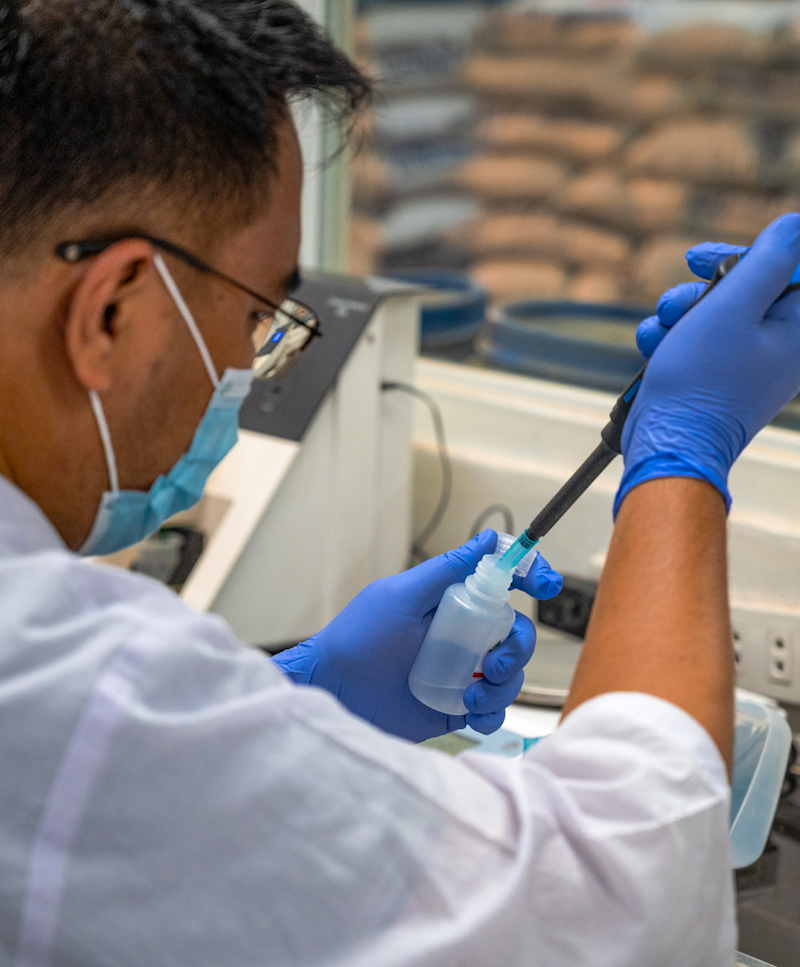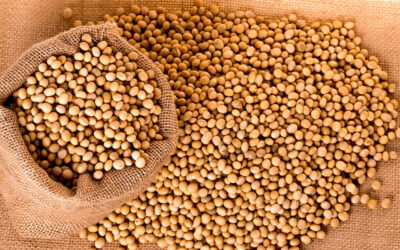
At Pilmico, our commitment to being a steadfast Partner for Growth remains unwavering. Understanding the unique needs of the large farm segment, often characterized by independence and diverse resources, we are excited to introduce Paragon. This groundbreaking initiative is poised to deliver unparalleled quality in Pork & Poultry Solutions, epitomizing our dedication to providing top-tier services to support the growth and success of our valued partners. Join us on this journey as we redefine industry standards and strengthen our collaborative bonds with the agricultural community.
Representing a model of excellence, Paragon is a comprehensive 360° program meticulously crafted with our partners in mind.

PRIME PRECISION
Expert nutritionists
State-of-the-art production
In-house feed analytics

ALL IN ONE
Genetics-appropriate nutrition
Health-fortifying design
Skilled veterinary consultants

REPUTABLE
Trusted brand in the industry
Guaranteed safe feeds
Frictionless transaction
Our custom feed solutions utilizes precise nutrition formulation and research-based growth models designed according to the customer’s specific needs.
Articles
Nurturing Sustainability: Pilmico’s Commitment to Eco-Friendly U.S. Soy
INTRODUCTION: As a company committed to sustainability, we proudly champion sustainably grown U.S. Soya as the cornerstone of our feed ingredients. We work with U.S. soybean farmers who are dedicated to land conservation and embrace diverse farming practices that...

Beyond the Basics:
Advanced Strategies for Poultry Nutrition

Welcome to
Poultry 365!
An event dedicated to exploring every facet of poultry management, with a specific emphasis on achieving nutritional excellence for unparalleled farm productivity.
In our inaugural year, our theme is ‘Beyond the Basics: Advanced Strategies for Poultry Nutrition’.
Delve into advanced nutritional strategies and technologies that push the boundaries of conventional poultry farming.
Symposium Topics
01

Responses of broiler chickens to different nutrient recommendations
View Abstract
In broad terms, dietary nutrients consist of water, energy (oxidation of feed ingredients), protein (amino acids), water, vitamins and minerals. However, the growth response of broilers will only be as good as the first limiting nutrient in the feed offered. Theory of feed intake in animals is that they desire to grow as quickly as possible to reach maturity and, reproduce to ensure survival of the specific species. In broiler chickens, the genetic potential for protein growth can be predicted and the nutrients to support that growth can then be calculated. Thus, if the nutrient concentration of the feed is known, the desired feed intake can easily be calculated.
Whilst broiler growth response is determined by nutrient intake, constraints preventing the bird from growing at its potential include the environment (temperature and humidity), disease and vaccine challenges, housing and management and the bulkiness of the feed itself. Additionally, feed form, such as crumble and pellet quality, are important in maximising feed intake. In commercial conditions, these factors collectively result in a constrained feed intake, requiring mechanistic modelling approaches to predict actual feed, or nutrient, intake. Ultimately, the role of the Nutritionist is to find the optimum balance between broiler growth response, feed nutrients and economics for the business within a given environment. Broiler genetics have advanced considerably over the past 100 years due to genetic selection for growth that is nearly 10 times greater than a century ago. Furthermore, mortality has declined by 78% and lean meat yield has dramatically increased over the same period. Whilst the annual rate of growth performance improvement has declined, the broiler continues to gain annually by one-fifth of a day less to reach 2.25 kg livemass, 0.1% increased eviscerated yield and 1.8 points of improved FCR.
Primary breeders produce nutrition guides for broiler chickens but, growth responses differ geographically with a Ross 308 broiler in New Zealand (NZ) 63% heavier (3.46 versus 2.13 kg) than a hot, humid environment in Asia at 40 days post-hatch. The FCR to reach these respective weights is 12.9% better (1.301 versus 1.493) in NZ. Temperate environmental temperature and humidity, combined with low disease challenges result in improved broiler growth response in NZ. Improved broiler performance is primarily driven by increased feed intake, enhanced by excellent crumble and pellet quality with wheat-based diets.
In conclusion, there are no nutrient “requirements” for broilers but rather “responses” to nutrient intake within constraints that the Nutritionist needs to identify. The maximum broiler growth response may not be the economic optimum and, the ultimate goal is to maximise profit margin over time, within integrated broiler operations.
View Material
Watch Presentation
Peter Chrystal, PhD
Aviagen
02

Influence of different feed forms quality on the growth efficiency of broiler chickens
View Abstract
The development of feed imaging has been an important step to understanding the processed feed quality. The current model of feed processing does not yield the full chemical and structural potential of starches in the feed for pellet binding and energy value. We now understand why the classic feed pelleting process leads to starch being under processed with a high degree of crystalline particles, affecting digestibility and rendered it unavailable. The same applies to protein processing. Feed imaging enables us to monitor thermal heat processing for positive chemistry changes to starch and protein without the negative Maillard reaction chemistry, to maximize nutrient yield that is otherwise difficult to control.
Feed formulation is centered around providing the correct energy and protein levels that each species of animal needs. Feed processing should therefore be focused on enhancing the feeding value of these important dietary nutrients. Proper processing of starch and protein is critically important and a key to the processed feed quality and also to the feed costs. Feed processing plays a pivotal role towards feed quality and farm productivity. Addressing the fundamental of doing this business productively and profitably will set the stage for a resilient and sustainable future for the livestock industry.
Our imaging technology is an exciting new tool for the industry to control avoidable processing losses and improve nutrient utilization. Very simply, available energy and nutrient in feedstuffs that can otherwise be harvested from thermal feed processing is being lost. We now have the tools to make these losses visible, the chemistry to reduce the losses and the engineering expertise to implement these cost saving methods. It may sound too good to be true, but there is indeed USD20-40 per MT on the table to be captured by this novel approach to feed processing.
View Material
Watch Presentation
Steven Goh
DelstAsia
03

Major mycotoxins in feed: Status, detection, mitigation and management
View Abstract
Mycotoxins are toxic secondary metabolic products of fungi which impair health and performance of animals. The combination of high moisture and temperature due to global warming and climate change provides ideal conditions for mycotoxin development in commodities, spotlighting the need to better understand and effectively protect the animal industry on the upcoming years. To date, more than 1000 mycotoxins were identified, those of major concern in animal feed industry are Aflatoxins, Fumonisins, Deoxynivalenol (DON), T2 toxin, Zearalenone, Ochratoxin A and Ergot Alkaloids. European Food and Safety Authority (EFSA), the world’s premier reference and authority on mycotoxins, have been reviewing guidelines on toxicity for the animal species, as well as, further developing research on emerging and masked mycotoxins. Emerging mycotoxins are newer forms of mycotoxins which are neither routinely determined nor regulated. Masked mycotoxins consist in the original compound bound to molecules which make them undetectable using conventional analytical methods.
To understand the mycotoxin profile in Philippines, a study was conducted across feed and ingredients in using LC MS/MS methodology. A total of 276 samples were analyzed between 2021 and 2024 and Fumonisins were top ranked with a prevalence of 95% to 82%. Followed by Aflatoxins B1 (78%)DON (36%), Ochratoxin A (35%) and Zearalenone (30%) from the regulated mycotoxins. While emerging mycotoxins such as Moniliformin (33%), Sterigmatocystin (31%), Beauvericin (22%), Alternariol (16%) were also identified. Masked form of DON (Deoxynivalenol-3 Glucoside) was present in 19% of the samples while metabolites of Zearalenone (beta-Zearalenol, Zearalanone and alpha-Zearalenol) were present in 16%, 15% and 8%, respectively. Close to 39% of the samples have shown co- contamination of 3-4 mycotoxins while roughly 50% were determined to have 5-9 mycotoxins in co-occurrence.
From this information it’s possible to notice that even moderate levels of mycotoxins can prejudice animal health as additive and synergistic effects among them potentialize detrimental effects in the organism, highlighting the need for an effective mycotoxin solution. Using a binder alone will only address counteraction for Aflatoxins and Ergot Alkaloids, which be effectively bound. Fumonisins, Zearalenone and Deoxynivalenol, together with their masked forms, need a proven bio-transformation strategy to mitigate the risks and negative effects. For emerging mycotoxins, an additional bio-protection strategy to promote liver and gut health in the face of these threats is also essential. Overall, a well-established, proven, and effective Mycotoxin Risk Management is key to addressing the growing mycotoxin risks to the Philippine’s animal industry.
View Material
Watch Presentation
Lorran Gabardo, DVM, MSc
dsm-firmenich
04

Intestinal microbiota and its interaction with organic acids, feed enzymes and phytogens
View Abstract
The gut microbiota is the complex of microorganisms which live in the intestine of animals. It is highly diverse, both within a single subject and between different individuals, and carries out several key functions, from nutrient metabolism to defence against infection to the regulation of the immune system.
Many microorganisms have positive effects, while others are pathogens and are detrimental for animals; the overall balance between the two depends on the specific conditions which are found in the gut, and studies have shown that it’s possible to alter this balance by modifying some parameters (e.g. intestinal pH) through the use of feed additives.
More recently, developments in the field of metagenomics have made it possible to determine exactly how the intestinal microbiome is altered in response to feed additives, allowing us to develop precise nutritional strategies to modulate the gut bacteria; these strategies might involve the use of feed additives such as organic acids, feed enzymes, or phytogens.
Organic acids have been widely studied because they have been traditionally used as preservatives in feed and food thanks to their ability to inhibit the growth of bacteria; they act by penetrating the bacterial cell wall and disrupting the physiology of the microbe. However, in vivo organic acids do not have the same effect because they do not reach the intestine, where the microbiota resides, unless they are protected.
Carefully-dosed feed enzymes can help modulate the intestinal microflora, because they enhance digestion and absorption, leaving fewer nutrients available for the gut microorganisms; it is however difficult to obtain a precise effect this way, because the enzymes only act indirectly on the microbiota, and not directly like other feed additives.
Lastly, phytogens (or phytogenics) are biologically-active secondary plant metabolites and essential oils, which have recently attracted attention because of their purported effects on several factors in animal production. The mechanisms through which phytogens act, however, have yet to be fully elucidated, and more studies should be done; furthermore, like organic acids, these substances do not reach their target, i.e. the intestinal microbiota, unless they are protected against gastric degradation in some way.
Overall, the response of the intestinal microbiota on feed additives is a field in which there are still several unknown factors: some products are effective, some are not effective, and some may be effective, and it’s often difficult to determine which products should be used and at what dosage.
View Material
Watch Presentation
Bruno Tempesta, PhD
Eurofeed Technologies
05

Key approaches in managing gut health without antibiotics in heat-stressed birds
View Abstract
Heat stress is a worldwide problem not only due to global warming. Of course climate alterations play an important role, but genetic changes over time to improve performance resulted in fast growing birds, which means increased animal heat production. Production performance of broilers is negatively affected by heat stress, not only as a result of a drop in feed intake and body weight gain (especially in fast growing broilers; Fig. 2), but also as a result of panting. Panting is a compensatory mechanism to dissipate body heat via evaporative cooling by the respiratory tract, leading to respiratory alkalosis by rapid loss of CO2, as well as extra loss of water. In a worst case scenario, acid-basic balance is disturbed with metabolic costs, being characterized by a drop in body cells pH, eventually resulting in bird death. Usually the effects are not that extreme to cause mortality, but affect animal production and intestinal function. Extra loss of water and electrolytes as Na+, K+ and Cl-, as well as decreased blood flow to the intestines, make intestines the most sensitive organs to heat stress. Heat stress leads not only to intestinal damage, but also to a change on its morphology. To compensate epithelial cell area loss, the intestinal structure is altered to minimize the impaired nutrient absorption (Santos et al., 2014), although it may be not fully efficient. The main strategies to counteract heat stress effects are focused on animal genetics, management and nutrition. In this circular we will focus on animal nutrition. Nutritional intervention can be based on water and mineral supply, energy, protein, feed additives, but also on feed form and feeding schedule.
View Material
Watch Presentation
Roger Davin, DVM, MBA, PhD
Schothorst Feed Research
06

Factors affecting intestinal frontier integrity in birds under thermal stress
View Abstract
The intestinal frontier integrity of birds is a critical determinant of their overall health, particularly under conditions of thermal stress. Heat stress, characterized by elevated ambient temperatures, exerts a profound impact on the physiological and biochemical pathways maintaining gut integrity. The primary consequence of heat stress is the disruption of the gut barrier function, leading to increased permeability and susceptibility to enteric pathogens. Mechanistically, heat stress induces a state of hyperthermia, which compromises the tight junctions between enterocytes. This is further exacerbated by the resultant oxidative stress, which damages cellular component and disrupts absorptive and barrier functions.
Additionally, heat stress alters the normal blood flow distribution within the body, shunting blood away from the gastrointestinal tract to facilitate heat dissipation. This leads to hypoxia in the gut tissues, impairing nutrient absorption and weakening of the mucosal defense. The stress response also triggers the release of corticosterone, which negatively affects gut motility and exacerbates the inflammatory response. The altered gut environment under heat stress favors dysbiosis, with a shift in the microbial population that can further undermine the integrity of the intestinal barrier.
Understanding these mechanisms is crucial for developing nutritional and management strategies to mitigate the adverse effects of heat stress on the intestinal health of birds. Such strategies may include the use of dietary antioxidants, probiotics, and optimizing feeding schedules to maintain gut homeostasis and enhance the resilience of the intestinal frontier against thermal challenges.
View Material
Watch Presentation
Maximillian Sim, DVM
dsm-firmenich
07

Roles of protein and amino acids in enteric health management and stress response mitigation in poultry
View Abstract
The poultry industry traditionally used crude protein requirements to supplement necessary digestible amino acids for optimum body protein deposition. However, using crude protein as a target to meet the digestible amino acid requirement increases the risk of enteric disease and increases the maintenance energy requirement of birds. Shifting the current crude protein target to a digestible amino acids target can save the need for energy inclusion in the diet and also reduce energy and essential amino acid partitioning towards the immune system. In addition, the ideal amino acid pattern for optimum muscle protein deposition is changing when animals are under stress/inflammation challenges, particularly when poultry industry excludes the use of prophylactic AGP. This presentation will cover how best formulators can cope with the current/future challenges to meet the animal’s physiological requirement of amino acids under various environmental stress conditions.
View Material
Watch Presentation
Jae Cheol Kim, PhD
CJ Bio
08

Impact of dietary antioxidants on oxidative stress in poultry
View Abstract
Natural antioxidants are essential for maintaining the health, productive, and reproductive performance of chickens, including breeders, layers, rearing birds, and growing broilers. The body contains a variety of antioxidant molecules such as vitamin E, carotenoids, selenium, ascorbic acid, coenzyme Q, carnitine, taurine, and antioxidant enzymes. These antioxidants work together to form the antioxidant network known as “antioxidant systems,” with selenium (Se) being the “chief executive.” Current research on selenium’s role in antioxidant defenses in poultry demonstrates its modulatory effects at various stages, including breeders, developing embryos, newly hatched chicks, and postnatal chickens.
Selenium is involved in the expression and synthesis of 25 selenoproteins, including GSH-Px, TrxR, and SepP, and it influences both non-enzymatic (vitamin E, CoQ, and GSH) and enzymatic (SOD) antioxidant defense mechanisms, thereby enhancing overall antioxidant defenses. The efficiency of selenium depends on the level of supplementation and the form of dietary Se, with organic Se sources being more effective than sodium selenite in modulating antioxidant systems in poultry. Notably, selenium levels in eggs from certain wild avian species are comparable to those found in chicken eggs after 0.3 ppm organic Se supplementation. Identifying the most effective dietary form of organic Se remains a priority in poultry nutrition. Future research should focus on the antioxidant/prooxidant (redox) balance of the gut and the role/interactions of selenium and microbiota in maintaining gut health.
View Material
Watch Presentation
Vishwas Gowda, DVM
Adisseo
Gallery
Access the Presentors Decks
Topic 1:
Responses of broiler chickens to different nutrient recommendations
Dr. Peter Chrystal
Aviagen
Topic 2:
Influence of different feed forms , pellet/crumble quality on the growth ffficiency of broiler chickens
Steven Goh
Delstasia S/B
Topic 3:
Major mycotoxins in feed: Status, detection, mitigation and management
Dr. Lorran Gabardo
DSM Nutritional Products
Topic 4:
Intestinal microbiota and its interaction with organic acids, feed enzymes and phytogens
Dr. Bruno Tempesta
Topic 5:
Intestinal microbiotaKey approaches in managing gut health without antibiotics in heat-stressed birds
Dr. Roger Davin
Schothorst Feed Research
Topic 6:
The factors affecting intestinal frontier integrity in birds under thermal stress
Dr. Maximilian Sim
DSM- Eubiotics
Topic 7:
Roles of protein and amino acids in enteric health management and stress response mitigation in poultry
Dr. Jae Cheol Kim
Asian-Australasian Journal of Animal Sciece
Topic 8:
Impact of dietary antioxidants on oxidative stress in poultry
Dr. Vishwas Gowda Adisseo’s Health by Nutrition


